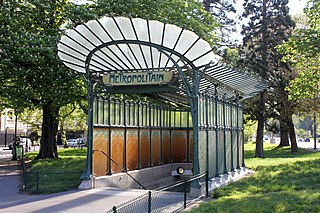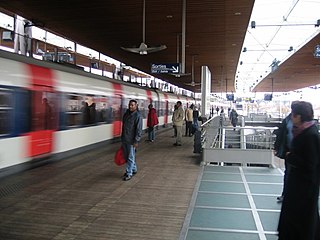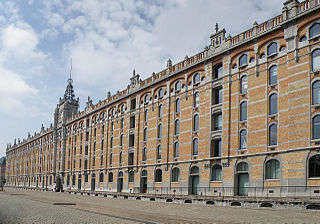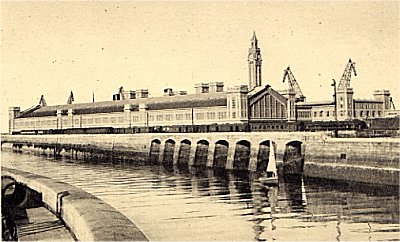
The Paris Métro, short for Métropolitain, is a rapid transit system in the Paris metropolitan area, France. A symbol of the city, it is known for its density within the city limits, uniform architecture and unique entrances influenced by Art Nouveau. It is mostly underground and 214 kilometres (133 mi) long. It has 302 stations, of which 62 have transfers between lines. There are 16 lines, numbered 1 to 14 with two lines, 3bis and 7bis, which are named because they started out as branches of Line 3 and Line 7; later they officially became separate lines. Lines are identified on maps by number and colour, with the direction of travel indicated by the terminus.

Cherbourg-Octeville is a city and former commune situated at the northern end of the Cotentin peninsula in the northwestern French department of Manche. It is a subprefecture of its department, and was officially formed when the commune of Cherbourg absorbed Octeville on 28 February 2000. On 1 January 2016, it was merged into the new commune of Cherbourg-en-Cotentin. The city is a Maritime prefecture and sub-prefecture of la Manche. Due to its union, it is the most populated city in its department with 37,121 inhabitants making it the first city of the department before the Saint-Lô prefecture and the second in the region after Caen.

Paris Charles de Gaulle Airport, also known as Roissy Airport, is the largest international airport in France and second-busiest airport in Europe. Opened in 1974, it is located in Roissy-en-France, 23 km (14 mi) northeast of Paris. It is named after Charles de Gaulle (1890–1970).

The Réseau Express Régional, commonly abbreviated RER, is a hybrid suburban commuter and rapid transit system serving Paris and its suburbs. The RER combines the operations and roles of a local city-centre underground rail system and suburbs-to-city-center commuter rail. Inside the city center, the RER functions much like the Métro, but is faster as it has fewer stops. This has made it a model for proposals to improve transit within other cities.

The Gare d'Austerlitz, officially Paris-Austerlitz, is one of the six large terminus railway stations in Paris. It is situated on the left bank of the Seine in the southeastern part of the city, in the 13th arrondissement. It is the start of the Paris–Bordeaux railway; the line to Toulouse is connected to this line. Since the introduction of the TGV Atlantique – using Gare Montparnasse – Austerlitz has lost most of its long-distance southwestern services. It is used by some 30 million passengers annually, about half the number passing through Montparnasse.

The Gare du Nord, officially Paris-Nord, is one of the six large terminus stations of the SNCF mainline network for Paris, France. It serves train services toward regions north of Paris, along the Paris–Lille railway. Near Gare de l'Est in the 10th arrondissement, the Gare du Nord offers connections with several urban transport lines, including Paris Métro, RER and buses. By the number of travelers, around 222 million per year, it is the busiest railway station in Europe by total passenger numbers.
The RER D is one of five RER lines serving Paris, France. It connects Orry-la-Ville and Creil in the north to Melun, Corbeil-Essonnes and Malesherbes in the south, passing through the heart of Paris.

Kiev-Pasazhyrskyi is a railway station in the capital of Ukraine, Kiev. It is a big complex and railway hub consisting of several railroad station buildings, railyard, and other railroad infrastructure such as the Kiev Electrical and Railcar Maintenance Factory. The station is located on so called Kiev Southern Railway loop.
The Compagnie des chemins de fer de l'Ouest, often referred to simply as L'Ouest or Ouest, was an early French railway company.

Place Viger was both a grand hotel and railway station in Montreal, Quebec, Canada, constructed in 1898 and named after Jacques Viger, the first Mayor of the city. Although combined stations and hotels were common in the United Kingdom in the late 19th century, Place Viger was the only such combination in Canada.

The Gare du Sud is a former French railway station located in the Libération quarter of the city of Nice in south-east France. The station was the terminus of the metre gauge railway of the Chemins de Fer de Provence rail company which links Nice to Digne-les-Bains in the department of Alpes-de-Haute-Provence. The station was closed in December 1991 when it was replaced by the Gare de Nice CP station. It remained derelict until 2013, when the station building was renovated and converted into a library.

Gare Maritime de Dieppe was a railway station in the town of Dieppe, Seine-Maritime, France and was built by CF de l'Ouest in 1874. The station was the station for passengers from Paris to Newhaven, by steamers and then ferries.

Limoges-Bénédictins is the main railway station of Limoges. It is situated on the Orléans–Montauban railway. It was named Bénédictins due to the presence of a Benedictine monastery closed during the French Revolution.

Gare de Cherbourg is the railway station of the city of Cherbourg, France. It is the western terminus of the Mantes-la-Jolie–Cherbourg railway.

Luxembourg railway station is the main railway station serving Luxembourg City, in southern Luxembourg. It is operated by Chemins de Fer Luxembourgeois, the state-owned railway company.

Strasbourg-Ville is the main railway station in the city of Strasbourg, Bas-Rhin, France. It is the eastern terminus of the Paris-Est–Strasbourg-Ville railway. The current core building, an example of historicist architecture of the Wilhelminian period, replaced a previous station inaugurated in 1852, later turned into a covered market and ultimately demolished.
With over 20 million passengers in 2018, Strasbourg-Ville is one of the busiest railway stations in France, second only to Lyon-Part-Dieu outside of the Île-de-France.

Gare de Tours is a railway station serving the city of Tours, Indre-et-Loire department, western France. It is situated on the Paris–Bordeaux railway, the Tours–Saint-Nazaire railway, and the non-electrified Tours–Le Mans railway. The Gare de Tours is a terminus; most TGV trains only serve the nearby Gare de Saint-Pierre-des-Corps.

The Gare de Metz-Ville is the main railway station serving the city of Metz, capital of Lorraine, France. Sometimes spoken of as the Station Palace as it displays the apartments of the German Kaiser Wilhelm II, Metz station has been registered as a Historic Monument since 15 January 1975. This designation gives legal protection to the station's facade, the roof, the departure hall, the honorary lounge, and the former station restaurant with its interior decorations.
The Grands Projets of François Mitterrand was an architectural program to provide modern monuments in Paris, the city of monuments, symbolizing France’s role in art, politics, and economy at the end of the 20th century. The program was initiated by the 21st President of France while he was in office. Mitterrand viewed the civic building projects, estimated at the time to cost the Government of France 15.7 billion FF, both as a revitalisation of the city, as well as contemporary architecture promoted by Socialist Party politics. The scale of the project and its ambitious nature was compared to the major building schemes of Louis XIV.

Tour & Taxis is a large former industrial site in Brussels, Belgium.


















